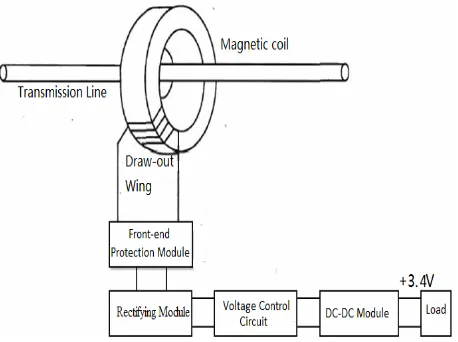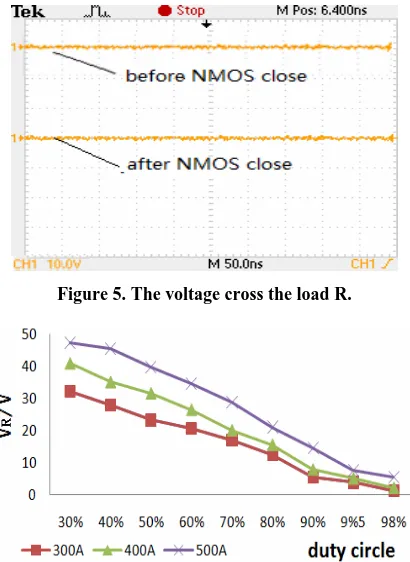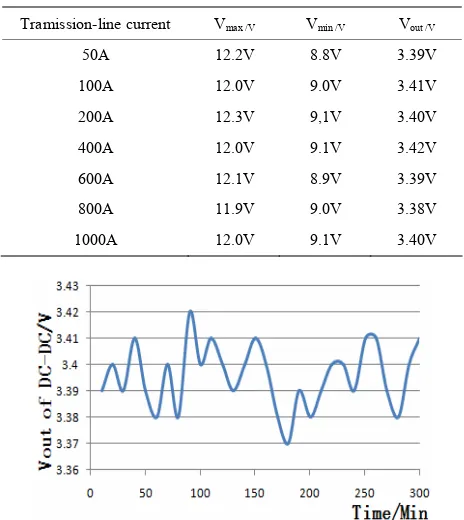Design of Power Supply for On-line Monitoring
System of Transmission Lines
Kai Chen1, Zi-jian Zhao1, Yu-ning Zhang1, Yang-chun Cheng1, Yuan Dai2 1State Key Laboratory of Alternate Electrical Power System with Renewable Energy Sources,
Beijing Key Laboratory of High Voltage and EMC, North China Electric Power University, Beijing, China 2Guangdong Power Test & Research Institution, Guangzhou, Guangdong Province, China
Email: 570940746@qq.com
Received March, 2013
ABSTRACT
This paper uses CT to gain the energy directly from the high-voltage transmission line, to address the problem of power supply for monitoring system in high voltage side of transmission line. The draw-out power coil can induce voltage from the transmission line, using single-chip microcomputer to analog and output PMW wave to control the charging module, provides a stable 3.4 V DC voltage to the load, and solve the problem of easy saturating of core. The power supply based on this kind of draw-out power coil has undergone the overall testing, and it is verified-showing that it can properly work in a non-saturated status within the current range of 50 - 1000 A, and provide a stable output. The equipment also design protection circuit to improve the reliability to avid the impacts of the impulse current or short-circuit current. It effectively solves the problem of power supply for On-line Monitoring System of Transmission.
Keywords: Monitoring System; Power Supply of High-voltage Transmission Line; Draw-out Power Coil; Single-chip
Microcomputer
1. Introduction
The monitoring devices need to be installed directly in the transmission lines, so how to provide electrical power for the devices is one of the key issues we need to re-solve. The power supply of study has important practical value. Now the most widely used method is the solar energy [1], but this method is susceptible to affected by climatic conditions, and lack of long-term mainte-nance-free capacity. The laser energy has been applied in the electronic current transformers and active optical current transformer [2, 3], but such power is not suitable for work in the field. Using the capacitive bleeder is the use of a capacitor to obtain energy from the high-voltage transmission, but the stability and reliability of this me-thod is poor, and the power of the meme-thod is limited [4]. The best way of power supply is using CT to take energy directly from the transmission lines. In this paper, a new power supply used in high-voltage buses is designed and verified by experiments.
2. Basic Schematic of CT Inductive Power
[image:1.595.310.539.550.721.2]The basic schematic of the power supply is shown in
Figure 1.
The basic principle of Using CT to obtain energy is based on the Faraday's law of electromagnetic induction.
Within the current range of 50 - 1000 A, using CT to induce from the high-voltage transmission, then after rectifying, voltage reduction, it can finally output stable 3.4V-DC voltage for on-line monitoring equipment.
3. Basic Principle of CT Inductive Power
3.1. The Theoretical Analysis of Draw-out Coil
The draw-out coil works like a transformer, its no-load equivalent model is shown in Figure 2.
Figure 2. No-load equivalent model of draw-out coil.
According to the knowledge of the electromagnetic theory [5,6], the secondary voltage valid value is:
2 2 2
U E 4.44 Nf m (1) where E2 is the magnetic induction electromotive force
RMS; f is the power frequency; N2 is the secondary-side
winding turns; Φm is the magnetic flux amplitude, the flux amplitude is:
B S m m k
(2) where Bm is saturation magnetic induction; k is laminated
coefficient.
According to Ampere's circuital law:
1 1 Hml 2NI
Hm
(3) where S is the cross-sectional area of the core; I is the average magnetic path length; I1 is the exciting current;
N is the primary winding turns, which takes one. The relation of magnetic induction peak and magnetic field strength peak is:
0
Bm r (4) where 0 is the vacuum permeability; r is the
rela-tive permeability of magnetic core; Hmis the peak of the
magnetic field strength. By the formulas (1)-(4) can be known:
0
2 2 2
2 S
4.44 N 4.44 N r I
m
k
E f f
l
m (5)
Form equation (5) we can be known that secondary- side output voltage of the coil is related to the primary side of the excitation current Im, and has no relation with the secondary-side current.
As is shown in Figure 3, from region 1 to region 4, the
magnetic induction B is approximately proportional to field strength H, growing with the increasing of H. But in the saturation region, when Hm increases, Bm slows down or even not increases. The formulas (1) and (2) show that, If Bm does not change, the secondary-side
voltage RMS E2 unchanged. So E2 does not grow with
the increasing of wire current in the saturation region. The literature [7] and experiment results show that the waveform of induced voltage distorts seriously and be-comes into a narrow pulse waveform in deep saturation, which is a big challenge for the follow-up circuit. To solve this problem, to increase the magnetic saturation
current ,the ways such as adding air gap to the power coil [8] and using feedback compensation control [7] have certain effects. But the air-gap width is hard to control and the structure is too complex, both of which have a bad effect on the reliability of the power.
3.2. Front-end Protection Module
When the transmission line being struck by lightning or short circuit, especially the lightning stroke, the relay protection device could not work timely, it will cause the lethal threat to the power apparatus circuit. The impulse current does not only electrical harm but also mechanical harm to the power apparatus. On the one hand, the im-pulse current can cause the draw-out coil inducing a transient high voltage. On the other hand, it can cause huge electric force to destroy the draw-out coil. In this paper, the double polarity transient suppression diode (TVS) and the voltage dependent resistor are paralleled as front-end protection, and filling with a soft buffer layer between the core and winding to reduce the impact of the electric force.
3.3. Voltage Control Circuit
The preceding analysis shows that, when the transmis-sion-line current is higher than a certain value, the draw- out coil becomes saturated. The wave of secondary in-duced voltage become a peaked wave or even a high- amplitude pulse wave, so measures must be taken to limit the excessive voltage to prevent the DC-DC module from damage. Equation (5) shows that,when the draw-out core parameters and the turns of the secondary winding is a fixed value,the coil’s secondary-side output voltage E2
is only related to the primary side of the excitation cur-rent Im. The higher the voltage E2,the greater the
excita-tion current Im. In order to suppress the draw-out coil into
[image:2.595.310.538.568.717.2]saturation, we can reduce the secondary-side voltage of draw-out core to control the input voltage of the DC- DC circuit within the certain range.
The voltage control circuit is shown in Figure 4,
com-prising a control signal circuit and a step-down circuit. Step-down circuit is mainly composed of NMOS tran-sistor Q1 and charge-storage capacitor C. When the DC-
DC module input voltage is too high, Q1 will work and
discharge excess energy, to achieve the purpose of re-ducing voltage. Control signal circuit is constituted by the microcontroller of programmable counter array. When the voltage of the energy storage capacitor C ex-ceedsthe normal operating range, the Q1 will be
switch-ed by the control of the microcontroller. Specifically, as shown in Figure 4, the normal operating range of
en-ergy-storage capacitor C voltage Vc is disposed as
Vc1-Vc2. When Vc is higher than maximum normal
oper-ating voltage Vc2, the microcontroller outputs a high level
signal to close the NMOS transistor Q1. The excess
en-ergy is discharged through Q1 and the load is powered by
C, capacitor C supplies power for the load and its termi-nal voltage Vc decreases. When Vc is lower than
mini-mum normal operating voltage Vc1, the control signal
circuit have no output and the Q1 open. The output power
of the rectifier circuit directly supply to the load and charge-storage capacitor C.
The protection circuit includes a voltage regulator tube W1, current limiting resistor R1 and the grounding
resis-tance R2. When the voltage Vin exceed the breakdown
voltage of W1, W1 is turned on, the current flowing
through W1 and producing a voltage drop on R2.
There-fore, the NMOS transistor Q1 discharges the excess
en-ergy.
To verify whether the circuit can achieve the purpose of reducing voltage, we use the signal generator to re-place the control circuit. It loop outputs different duty- cycle PWM wave to control the step-down circuit, using 47 Ω resistors R as the load. As shown in Figure 5, the
transmission-line current is 200 A, after Q1 is completely
turned on, the voltage of R reduce from 30V to almost 0 V. As shown in Figure 6, when the transmission line
current are 300 A, 400 A and 500 A,with the increase of the duty cycle of the control signal, the voltage across the resistor R gradually reduce. When the duty cycle of the control signal is about 90%, the voltage is about 10 V. The purpose of the step-down can be achieved.
Figure 4. The voltage-control circuit.
4. Experimental Results and Analysis
4.1. Experimenting Platform
We choose the U93-MnZn ferrite U-shaped magnetic core which is produced by the Ferroxcube Company. after the calculation and experiments, the turns is chosen as 400, the diameter of enameled wire is chosen as 1mm.The draw-out coil can set in the transmission line with special design shell.
The experimenting platform is shown in Figure 7. The
[image:3.595.321.526.274.555.2]input of voltage regulator connect to 220V/50Hz AC, the current-generator output is short connecting for produc-ing high current. It can change the output current of the current-generator by regulating the voltage regulator. For facilitating to measure the current of the draw-out coil,
[image:3.595.313.536.600.718.2]Figure 5. The voltage cross the load R.
[image:3.595.64.287.612.722.2]Figure 6. The relation diagram between the voltage of R and the duty cycle.
the high-accuracy current transformer is used to detect the current.
4.2. Testing Result and Analysis
When in start current 50 A, we need to test weather draw- out coil can provide enough power. We Use a variable resistor to simulate the changing load to test the coil output power. Experiments show that the coil output is related to the load. As is shown in Figure 8,with the
current-generator output current I1=50 A, when the load
resister R is 150 Ω, the coil output power P2 reach the
maximum, as high as 653 mW. It can supply sufficient power for the load.
The design requirements of the draw-out power are that the starting current is 50 A, it can provide more than 500mW power the load (the normal operating power of the transmission line monitoring device with a GPS module is about 500 mW) and it can work stably within the range of 50 A to 1000 A of the transmission-line cur-rent.
Using 47 Ω resistors R as load, the power apparatus based on the above parameters is tested in the experi-ments. Form Figure 9, we can find that the maximum
voltage of storage-capacitor C is 12.0 V, minimum volt-age is 9.0V. When the NMOS transistor Q1 close, the
energy-charge capacitor C directly supply energy for load and its terminal voltage Vcdecrease. When Q1 open,
the output power of the rectifier circuit directly supply to the load and charge capacitor C, the voltage Vc of C will
increase. In Table 1, Vmax is the maximum input voltage
of DC-DC, Vmin is the minimum voltage of DC-DC, Vout
is the output voltage.
After the voltage-control circuit, DC-DC module input is 9.0 - 12.0 V and out a 3.4 V voltage within the range of 50 A to 1000 A bus current. With bus current 300A,
the power apparatus continue working 300 minutes, the ripple wave within 300 minutes of DC-DC output volt-age Vout is shown in Figure10. After the DC-DC module,
the power apparatus can provide a stable 3.4 V voltage.
[image:4.595.322.525.84.221.2]Figure 8. The relationship curve between the output power and the load.
[image:4.595.307.539.259.519.2]Figure 9. The voltage cross energy-shortage capacitor C.
Table 1. The output and input voltage of the DC-DC circuit.
Tramission-line current Vmax /V Vmin /V Vout /V
50A 12.2V 8.8V 3.39V
100A 12.0V 9.0V 3.41V
200A 12.3V 9,1V 3.40V
400A 12.0V 9.1V 3.42V
600A 12.1V 8.9V 3.39V
800A 11.9V 9.0V 3.38V
[image:4.595.306.539.262.518.2]1000A 12.0V 9.1V 3.40V
Figure 10. The ripple wave within 300 minutes of DC-DC output voltage.
5. Conclusions
In this paper, we study the issue about the power for the high-voltage on-line monitoring device. The analysis shows that using CT to induce energy is a low-cost, prac-tical and viable way.
REFERENCES
[1] S. B. Jiao, D. Liu, G. Zheng, et al., “On Line Insulator Contamination Monitoring System for Transmission Lines Based on Telemetry,” Automation of Electric Power Systems, Vol. 28, No. 15, 2004, pp. 71-75.
[2] T. C. Banwell, R. C. Estes and L. A, Reith, et al., “Pow-ering the Fiber Loop Optically-a Cost Analysis,” Journal of Light Wave Technology, Vol. 11, No. 3, 1993, pp. 481-494.doi:10.1109/50.219583
[3] J. Song, P. G. Mclaren, D. J. Thomson, et al., “A Proto-type Clamp-on Magneto-optical Current Transducer for Power System Metering and Relaying,” IEEE Trans on Power Delivery, Vol. 10, No. 4, 1995, pp. 1764-1770.
doi:10.1109/61.473382
[4] Z. Qian, “Power Supply for High Voltage Circuit of Ac-tive Electronic Current Transformer,” High Voltage Ap-paratus, Vol. 40, No. 2, 2004, pp. 135-138.
[5] G.-Y. Qiu, Circuit, Beijing: Higher Education Press, 1999.
[6] Y-M Tang and N. Shi, “Electromechanics,” Beijing: China Machine Press, 2002.
[7] L. Fu, “Research on Power Supply of Hybrid Fiber Cur-rent Transducer,” Qinhuangdao: Yanshan University, 2004.



